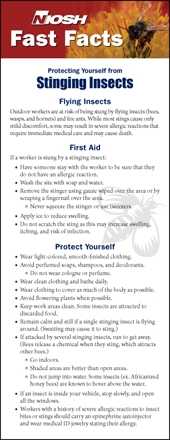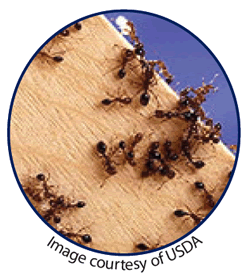NIOSH Fast Facts: Protecting Yourself from Stinging Insects
April 2010
DHHS (NIOSH) Publication Number 2010-117

Flying Insects
Outdoor workers are at risk of being stung by flying insects (bees, wasps, and hornets) and fire ants. While most stings cause only mild discomfort, some may result in severe allergic reactions that require immediate medical care and may cause death.
First Aid
If a worker is stung by a stinging insect:
- Have someone stay with the worker to be sure that they do not have an allergic reaction.
- Wash the site with soap and water.
- Remove the stinger using gauze wiped over the area or by scraping a fingernail over the area.
- Never squeeze the stinger or use tweezers.
- Apply ice to reduce swelling.
- Do not scratch the sting as this may increase swelling, itching, and risk of infection.
Protect Yourself
- Wear light-colored, smooth-finished clothing.
- Avoid perfumed soaps, shampoos, and deodorants.
- Do not wear cologne or perfume.
- Wear clean clothing and bathe daily.
- Wear clothing to cover as much of the body as possible.
- Avoid flowering plants when possible.
- Keep work areas clean. Some insects are attracted to discarded food.
- Remain calm and still if a single stinging insect is flying around. (Swatting may cause it to sting.)
- If attacked by several stinging insects, run to get away. (Bees release a chemical when they sting, which attracts other bees.)
- Go indoors.
- Shaded areas are better than open areas.
- Do not jump into water. Some insects (ex. Africanized honey bees) are known to hover above the water.
- If an insect is inside your vehicle, stop slowly, and open all the windows.
- Workers with a history of severe allergic reactions to insect bites or stings should carry an epinephrine autoinjector and wear medical ID jewelry stating their allergy.
Fire Ants

Fire ants bite and sting. They are aggressive when stinging and inject venom, which causes a burning sensation. Red bumps form at the sting, and within a day or two they become white fluid-filled pustules.
First Aid
- Rub off ants briskly, as they will attach to the skin with their jaws.
- Antihistamines may help.
- Follow directions on packaging.
- Drowsiness may occur.
- Seek immediate medical attention if a sting causes severe chest pain, nausea, severe sweating, loss of breath, serious swelling, or slurred speech.
Protect Yourself
- Do not disturb ant mounds.
- Be careful when lifting items (including animal carcasses) off the ground, as they may be covered in ants.
- Fire ants may be found on trees and in water, so always look over the area before starting to work.
- Tuck pants into socks or boots.
- Workers with a history of severe allergic reactions to insect bites or stings should carry an epinephrine autoinjector and wear medical ID jewelry stating their allergy. Fire ants bite and sting. They are aggressive when stinging and inject venom, which causes a burning sensation. Red bumps form at the sting, and within a day or two they become white fluid-filled pustules.
Present and Potential Ranges of Imported Fire Ant Infestation

NIOSH Fast Facts: Protecting Yourself from Stinging Insects [PDF 620KB]
- Page last reviewed: June 6, 2014
- Page last updated: June 6, 2014
- Content source:
- National Institute for Occupational Safety and Health Education and Information Division


 ShareCompartir
ShareCompartir